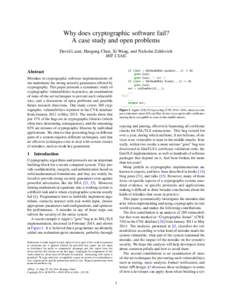
| Document Date: 2015-03-27 16:16:57
Open Document File Size: 121,71 KBShare Result on Facebook
City San Francisco / Seattle / Fairfax / Raleigh / Washington / DC / Berlin / Portland / Seoul / Beijing / Alexandria / Oakland / / Company AES / The MITRE Corporation / Microsoft / Apple / / Country Germany / China / South Korea / / Currency USD / / / Event FDA Phase / / Facility National Institute of Standards / Mozilla’s NSS library / SSL/TLS library / / IndustryTerm cryptographic software / cryptographic software implementations / software packages / cryptographic systems / secure cryptographic systems / individual applications / realworld systems / cryptographic protocol / cryptographic software fail / web logins / / OperatingSystem Mac OS X / Linux / Android / / Organization National Science Foundation / MIT / European Central Bank / / Person David Lazar / / Position tackle / Private / programmer / / Product One solution / / ProgrammingLanguage C / Python / / ProvinceOrState Virginia / Washington / North Carolina / California / / PublishedMedium Electronic Notes in Theoretical Computer Science / ARES / / Technology Linux / API / cryptographic protocol / block cipher / Android / html / SSL / Operating Systems / Introduction Cryptographic algorithms / pdf / Encryption / cryptography / public key / flow control / http / / URL www.schneier.com / http /
SocialTag |

